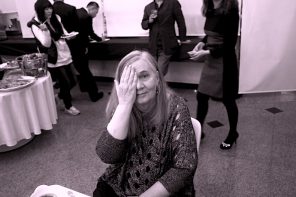What inspired you to write Spider in a Tree?
I live in Northampton, Massachusetts, across the road from a beautiful cemetery. It’s quiet there, with lots of big, generous trees and many old gravestones, going as far back as the seventeenth century. I was spending a lot of time there since it was beautiful and so close, walking and writing.
The names on the stones always drew me (who doesn’t want to imagine what a person named Thankful might actually be like?), and some of the epitaphs spoke even more directly, with lines designed to remind the living that we will all soon die. It was a little startling, and also strangely refreshing.
All of my previous books had been set mostly in Colorado and Texas, but I had lived in Massachusetts for decades, and my brother, Don Stinson, a landscape painter, suggested that I write a book set in the east. So, I was looking around, and it was literally the landscape, the earth in the cemetery with its small rises and falls, graves and markers, that led me to Jonathan Edwards and other people in Northampton in that time.
He’s not buried there, but there are two markers honoring him, and many other people who became fictional characters in the novel are there.
I had never read Jonathan Edwards, not even his most famous sermon, “Sinners in the Hands of an Angry God,” and once I started reading, I became enormously compelled by the beauty and immediacy of his language, the urgency of his moral concerns and the arc of his biography. It seemed almost Shakespearean to me.
What’s the most important take-home message for readers?
This is a novel, so it’s not so much intended to deliver a message as to offer a pleasurable, challenging act of historical imagination in language: a good story. I believe that the depth, insight, courage and nuance with which people engage with history is profoundly connected to the depth, insight, courage and nuance with which we engage with story.
I wanted, too, to write these eighteenth century Calvinists as convincing human beings, to evoke the world as they understood it, to honor their beliefs without distorting or denying parts of their culture that were ugly in their time and have left us terrible legacies, such as the practice of slavery.
Is there anything you had to leave out?
Yes. My four previous books all centered on the lives of fat lesbians, and when I started writing this novel, I was struck by how the intense experiences of revival, the intimacy of pastoral care, and the terrible conflict that developed between Edwards and most of the people in Northampton seemed parallel to some of the gifts and fights in the lesbian feminist community there as I’d know it in the 1980s and 90s.
It was fascinating to me that such different ideologies seemed to share such similar emotional and social arcs. I thought for a time of writing parallel stories set in the same geographic space in Northampton, one in the 1980s and the other in the 1740, but once I got into the eighteenth century, that story took over.
There are also vivid, compelling stories the years after Edwards and his family left Northampton, and in his grandparents’ generation, as well. I wanted to include them, but, again, it was too much for one book.
What are some of the biggest misconceptions about your topic?
Readers who come to the book thinking that they know everything that matters about Jonathan Edwards because they’ve read “Sinners in the Hands of an Angry God ” are likely to be startled by his commitment to and ability to evoke experiences of intense spiritual beauty. His sermons and treatises are intellectually rigorous. He was deeply interested in science and in his experiences with the landscape, because the God made the earth, and knowing in more deeply is a way of knowing more of the things of religion.
Also, I know I’m not alone in being startled to learn that Jonathan Edwards had an intimate, life-long relationship with slavery. Many Calvinist ministers enslaved people in their households. When I think about that, it makes popular ideas like the Protestant work ethic look different to me.
Did you have a specific audience in mind when writing?
One of the ways I found to approach the inner life of Jonathan Edwards is that we were/are both very ambitious. He wrote when he was young that he aspired to be the one true Christian of his age, even if nobody else could completely pull it off. Me, I would love to draw everyone into the world of this book.
Are you hoping to just inform readers? Entertain them? Piss them off?
Oh, yes, I’d love to entertain readers.
One of the reasons Moby Dick sticks around like it does is that it’s so amazingly fun. (See, ambitious.) I’d love it if readers left the book with a more embodied and engaged understanding of what Calvinism was and how people who embraced it lived in mid(ish) eighteenth century New England. I’d like to see northern slavery—its practices, implications and legacies—more widely acknowledged and examined.
What alternative title would you give the book?
I am married to the current title. It makes my head hurt to try to think of another one. Spider in a Tree is it!
How do you feel about the cover?
I love the cover so much. The artist is Elisabeth Alba. Her painting was inspired by an eighteenth century painting of the inside of a meeting house that the resourceful Kelly Link and Gavin Grant of Small Beer Press found. They consulted with me as the image was in progress, so I was able to do things like send them a copy of the seating chart for the Northampton meeting house and make suggestions. (They are publishers with high regard for the perceptions of their authors. I feel so lucky to have this book with them.) The cover is fun to look at, and it captures the essence of the book.
Is there a book out there you wish you had written? Which one? Why?
Ah, so many, really. I wish I had written Beloved by Toni Morrison because that is a novel that made the top of my head float off and let all sorts of difficult, necessary things pour in. I would have love to have written Tinkers by Paul Harding because of the gorgeous ways it works with illness, history, family and time. I would have loved to have written Gilead by Marilynne Robinson
What’s your next book?
I’ve been very tentatively fumbling around about that. I have some ideas, but the truth is that I am not quite sure.




